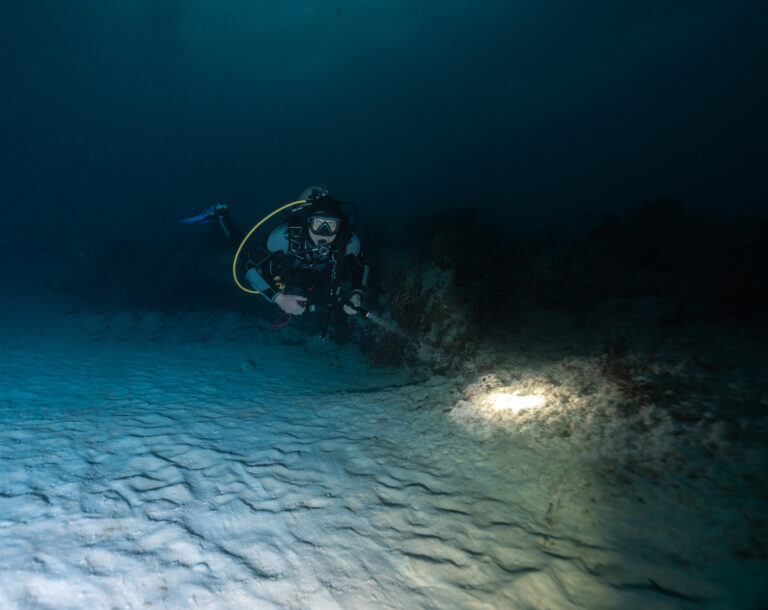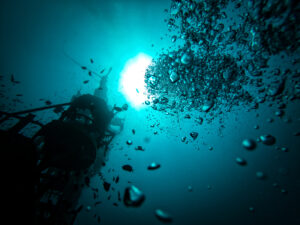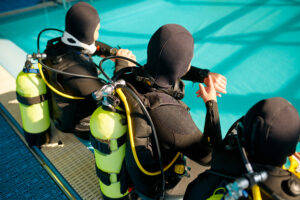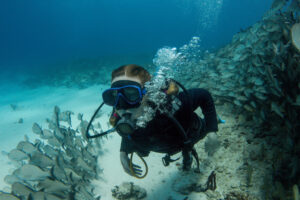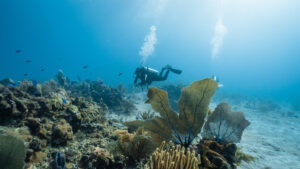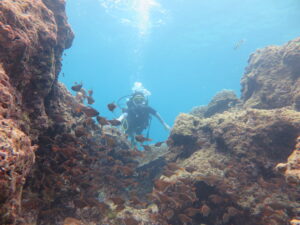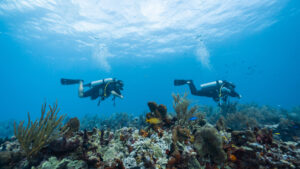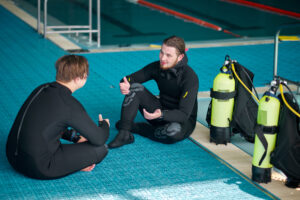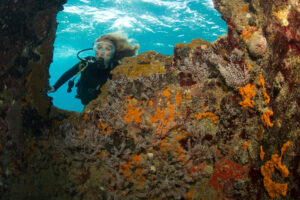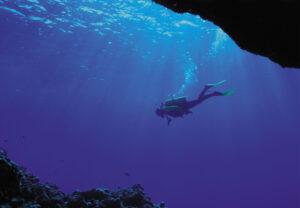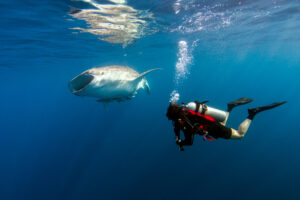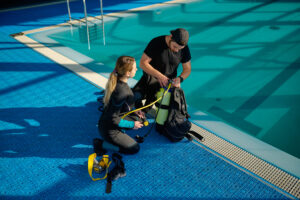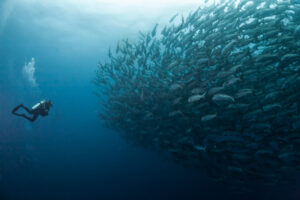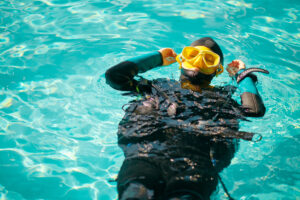What is a Repetitive Dive?
A repetitive dive is a dive that takes place after a previous dive within a certain period, usually within the same day. The critical aspect of a repetitive dive is the residual nitrogen that remains in the diver’s body from the previous dive. This residual nitrogen affects how subsequent dives are planned and executed to avoid decompression sickness, commonly known as “the bends.” Understanding repetitive dives is essential for divers to manage their dive profiles safely and to maximize their underwater experience without compromising their health.
Definition and Basic Concepts
Repetitive diving is a fundamental concept in scuba diving, defined as any dive performed before the body has completely eliminated the nitrogen absorbed during a previous dive. The period between these dives is known as the surface interval. The surface interval is crucial because it allows some nitrogen to off-gas from the body, but it is often not enough to return to baseline levels, making the management of nitrogen loading essential for safe diving practices.
The key difference between a single and a repetitive dive lies in the nitrogen levels in the diver’s tissues. After a single dive, a diver’s nitrogen levels are elevated, and a period of time is required for the body to off-gas this excess nitrogen. However, when a diver undertakes a repetitive dive, the pre-existing nitrogen levels influence the dive plan, requiring careful monitoring and adjustment to avoid the risk of decompression sickness.
Repetitive dives are particularly common in scenarios such as dive vacations, where divers often make multiple dives in a single day. Understanding how to manage these dives effectively is crucial for maintaining safety and ensuring a pleasant diving experience. This involves a combination of planning, using appropriate tools, and adhering to established safety protocols.
Physiological Impacts of Repetitive Diving
The physiological impact of repetitive diving is primarily related to the body’s absorption and elimination of nitrogen. When a diver breathes compressed air underwater, nitrogen dissolves into the blood and tissues at a higher rate due to increased pressure. The deeper and longer the dive, the more nitrogen is absorbed. Upon ascent, the pressure decreases, and nitrogen begins to off-gas from the tissues back into the bloodstream and is exhaled through the lungs.
In repetitive diving, the body starts the subsequent dive with elevated nitrogen levels from the previous dive. This residual nitrogen reduces the allowable bottom time for the next dive and increases the risk of nitrogen bubble formation, which can lead to decompression sickness. Decompression sickness occurs when nitrogen bubbles form in the tissues and bloodstream, causing symptoms ranging from joint pain and rashes to more severe conditions like paralysis and death.
Managing nitrogen levels effectively is crucial in repetitive diving. Divers must be aware of their no-decompression limits (NDLs), which are shorter for repetitive dives. The NDL is the maximum time a diver can stay at a given depth without needing to perform decompression stops during ascent. Exceeding these limits increases the risk of decompression sickness. Therefore, divers must carefully plan their dives, considering previous dives and allowing adequate surface intervals for nitrogen off-gassing.
The body eliminates nitrogen at a rate influenced by factors such as depth, duration of the dive, physical fitness, and individual physiology. Repetitive dives require longer surface intervals or conservative dive profiles to ensure safe nitrogen levels. By understanding these physiological impacts, divers can make informed decisions and mitigate risks associated with repetitive diving.
Planning and Safety Measures
Effective planning and safety measures are paramount in repetitive diving to ensure divers do not exceed safe nitrogen levels. One of the essential tools for managing repetitive dives is the dive table or dive computer. These tools help divers track nitrogen absorption and off-gassing, providing guidelines for maximum dive times and surface intervals to minimize the risk of decompression sickness.
Dive tables, such as the U.S. Navy or the Recreational Dive Planner (RDP), offer a structured way to calculate safe dive profiles. Divers use these tables to determine their allowable bottom time for the first dive and subsequent repetitive dives based on the surface interval. The tables provide different compartments representing theoretical tissue groups, each with specific nitrogen absorption and elimination rates. By referring to these tables, divers can adjust their dive plans to remain within safe limits.
Dive computers have become an integral part of modern diving, offering real-time monitoring of nitrogen levels and providing personalized dive profiles. These devices continuously calculate the diver’s exposure to nitrogen based on depth and time, adjusting for residual nitrogen from previous dives. Dive computers also alert divers to their NDLs and required surface intervals, making it easier to manage repetitive dives safely.
Examples of common repetitive dive scenarios include a morning dive followed by an afternoon dive or multiple dives over consecutive days. In these situations, divers must pay attention to their dive profiles and ensure they do not exceed their NDLs. They should also plan for sufficient surface intervals between dives, allowing time for nitrogen to off-gas. For instance, a one-hour surface interval between dives can significantly reduce residual nitrogen levels, increasing safety margins for subsequent dives.
Adhering to safety measures such as maintaining adequate hydration, avoiding strenuous activities during surface intervals, and using enriched air nitrox (EANx) can further enhance safety in repetitive diving. EANx has a higher oxygen content and lower nitrogen content than regular air, reducing nitrogen absorption and allowing for longer bottom times and shorter surface intervals.
Technical Aspects
The technical aspects of repetitive diving involve understanding dive profiles, surface intervals, and how dive depth and duration influence nitrogen absorption and off-gassing. Dive profiles refer to the depth and duration of a dive, which directly impact the amount of nitrogen absorbed by the body. In repetitive diving, these profiles must be carefully managed to ensure safe nitrogen levels.
Surface intervals play a crucial role in repetitive diving, as they allow the body to off-gas some of the absorbed nitrogen. The longer the surface interval, the more nitrogen is eliminated, reducing the risk of decompression sickness on subsequent dives. However, even with adequate surface intervals, residual nitrogen remains in the body, necessitating conservative dive planning.
Dive depth and duration are significant factors in managing repetitive dives. Deeper dives result in higher nitrogen absorption, while longer dives increase the time nitrogen is dissolved in the tissues. Therefore, repetitive dives require adjustments to dive depth and duration to remain within safe limits. For example, a diver who has completed a deep dive in the morning might opt for a shallower dive in the afternoon to minimize additional nitrogen loading.
Understanding these technical aspects is essential for planning repetitive dives. Divers must be aware of their NDLs for each dive, adjusting their dive profiles and surface intervals accordingly. For instance, if a diver’s first dive reaches the NDL, the subsequent dive must be shorter and shallower, with an extended surface interval to ensure safety.
Dive Tables and Decompression Models
Dive tables and decompression models are indispensable tools for planning repetitive dives. Dive tables, such as the U.S. Navy tables and the Recreational Dive Planner (RDP), provide guidelines for safe dive profiles by calculating allowable bottom times and required surface intervals based on previous dives.
The U.S. Navy dive tables, developed for military divers, offer a conservative approach to repetitive diving, considering various factors such as depth, duration, and surface intervals. These tables are divided into different compartments representing theoretical tissue groups, each with specific nitrogen absorption and elimination rates. Divers use these tables to determine their residual nitrogen levels and plan subsequent dives accordingly.
The RDP, designed for recreational divers, is a simplified version of the U.S. Navy tables, making it easier for non-professional divers to plan their dives. The RDP provides similar guidelines for dive depth, duration, and surface intervals, helping divers manage nitrogen levels effectively during repetitive dives.
Dive computers, equipped with advanced decompression models, have revolutionized dive planning. These devices continuously monitor the diver’s depth and time, calculating nitrogen absorption and off-gassing in real-time. Decompression models, such as the Bühlmann and Reduced Gradient Bubble Model (RGBM), are integrated into dive computers, providing personalized dive profiles and alerts for safe diving.
The Bühlmann model, developed by Swiss physician Albert A. Bühlmann, uses a series of mathematical equations to calculate nitrogen absorption and elimination rates for different tissue compartments. This model is widely used in dive computers, offering a conservative approach to dive planning.
The RGBM, developed by Dr. Bruce Wienke, incorporates additional factors such as microbubble formation and dynamics, providing a more comprehensive approach to managing nitrogen levels. This model accounts for factors like dive depth, duration, surface intervals, and repetitive dives, offering enhanced safety for divers.
By using dive tables and decompression models, divers can plan their repetitive dives with greater accuracy, minimizing the risk of decompression sickness and ensuring a safer diving experience.
Common Practices and Examples
Repetitive diving is a common practice among divers, particularly during dive vacations or liveaboard trips where multiple dives are conducted in a single day. Understanding common practices and examples of repetitive dive scenarios can help divers plan their dives more effectively and safely.
A typical repetitive dive pattern might involve a morning dive followed by an afternoon dive, with a surface interval in between. For instance, a diver might complete a 30-minute dive to 18 meters (60 feet) in the morning, followed by a two-hour surface interval, and then conduct a 25-minute dive to 15 meters (50 feet) in the afternoon. In this scenario, the surface interval allows for some nitrogen off-gassing, but the diver must still account for residual nitrogen when planning the second dive.
Case studies of well-planned repetitive dives highlight the importance of adhering to safety protocols and using appropriate tools. For example, a group of divers on a liveaboard trip might conduct four dives in a day, with careful planning to ensure adequate surface intervals and conservative dive profiles. By using dive computers and referring to dive tables, these divers can manage their nitrogen levels effectively, reducing the risk of decompression sickness.
Common mistakes and misconceptions in planning repetitive dives include underestimating the importance of surface intervals, neglecting to account for residual nitrogen, and pushing dive limits too far. Divers must avoid these
pitfalls by adhering to established guidelines, using dive computers or tables, and maintaining a conservative approach to their dive profiles.
Proper hydration, avoiding alcohol, and getting adequate rest are also crucial practices for safe repetitive diving. These factors influence the body’s ability to off-gas nitrogen and reduce the risk of decompression sickness. Divers should also avoid strenuous activities during surface intervals, as physical exertion can increase nitrogen absorption and compromise safety.
By following these common practices and learning from examples, divers can enjoy multiple dives in a day while minimizing the risk of decompression sickness and ensuring a safe and enjoyable experience.
Advanced Considerations
Advanced considerations in repetitive diving involve understanding the impact of environmental factors and adjusting dive plans for special conditions. Factors such as water temperature, altitude, and the use of enriched air nitrox (EANx) can significantly influence nitrogen absorption and off-gassing, requiring careful planning and adjustments.
Cold water diving, for example, can increase the risk of decompression sickness due to the body’s reduced ability to off-gas nitrogen in colder temperatures. Divers must account for this by extending surface intervals, using thicker exposure suits to maintain body warmth, and planning shorter and shallower repetitive dives.
Altitude diving presents additional challenges, as the reduced atmospheric pressure at higher elevations affects nitrogen off-gassing. Divers at altitude must use adjusted dive tables or dive computers with altitude settings to ensure safe dive profiles. The reduced pressure at altitude means that even shallow dives can result in significant nitrogen absorption, necessitating conservative planning.
The use of EANx can enhance safety in repetitive diving by reducing nitrogen absorption and allowing for longer bottom times and shorter surface intervals. However, divers must be trained in using EANx and understand its limitations, including the need to monitor oxygen exposure and adhere to specific dive tables or computer settings designed for nitrox.
Advanced decompression strategies, such as using staged decompression or gas switches, may be necessary for very intensive repetitive diving scenarios, such as technical diving or professional diving operations. These strategies involve careful planning and execution to manage nitrogen and oxygen levels effectively, requiring advanced training and experience.
By understanding and addressing these advanced considerations, divers can further enhance their safety and performance in repetitive diving, adapting their dive plans to suit varying conditions and reducing the risk of decompression sickness.
Key Takeaways
Repetitive diving involves managing residual nitrogen from previous dives to prevent decompression sickness. Effective planning, using tools like dive tables and computers, and understanding physiological impacts are crucial. Divers must consider surface intervals, dive depth, duration, and environmental factors. Adhering to safety protocols and being aware of advanced considerations enhance safe repetitive diving practices.

